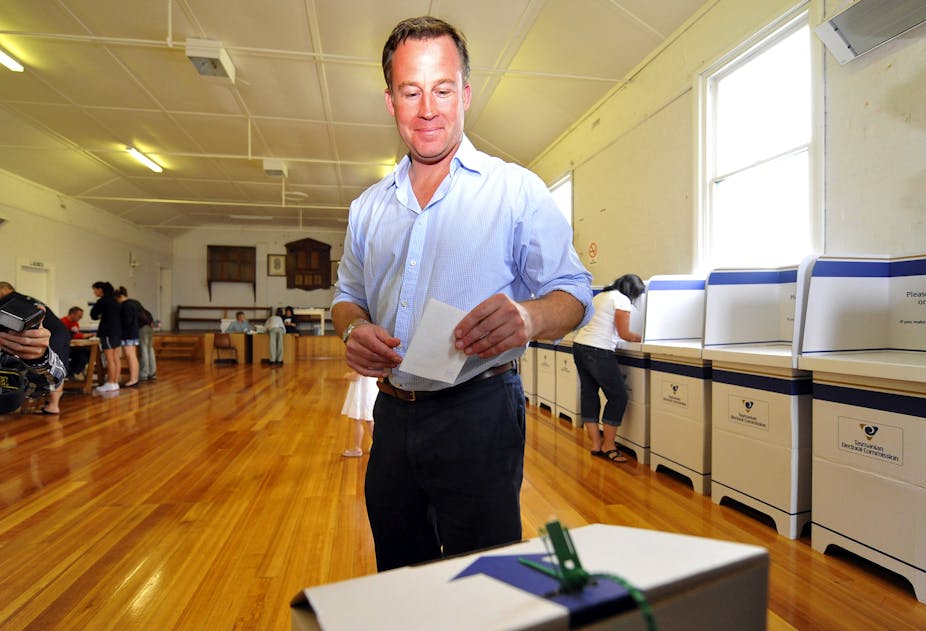After trading blows around predictable topics, the only issue of consensus in a recent televised debate between the leaders of the Tasmanian Liberal and Labor parties, Will Hodgman and Lara Giddings, was that minority government is not an option ahead of this Saturday’s state election.
Perhaps to emphasise this stance, members of other parties were excluded from the debate. This is despite the Greens sitting just 5.4% behind Labor in a recent poll and expectations the Palmer United Party will pick up one or possibly two seats, depending on the flow of preferences.
The reason minor parties – and the associated prospect of minority government – represent such a realistic threat in Tasmania is the Hare-Clark system that is used to elect the state’s lower house.
Under the system as it applies in Tasmania, there are five electorates which elect five members each. To be elected a candidate requires enough votes to fill a “quota”, or 16.67% of the vote. Candidates who do not gain a quota have their votes redistributed according to preferences. Candidates who receive more than a full quota also have their excess votes redistributed. The process continues until all five positions are filled.
The Hare-Clark system
Driven by the failure of a number of progressive bills relating to female suffrage, referendum and disenfranchisement, Andrew Inglis Clark, who introduced the system to Tasmania as state attorney-general, saw electoral reform as a way to modernise a staid and conservative Tasmanian establishment in the early 20th century.
Philosopher John Stuart Mill also supported the system, first devised by British political scientist Thomas Hare. Mill believed that proportional parliamentary reform would stop the defect that enabled:
…the strongest party to exclude all weaker parties from making their opinions heard in the assembly of the nation.
Complex but fair
Hare-Clark often invites criticism because of its complex counting process, but the basics are clear.
A number of factors are designed to reduce the influence of parties and factions becoming too powerful. There is no ticketed voting, so candidates are usually elected as a consequence of name and local visibility rather than party.
This also has the less useful effect of embedding low-level dynastic politics. For example, the current House of Assembly has a brother and sister combination and two sons of former premiers, while Hodgman’s father, uncle and grandfather were all members of Tasmanian parliament.
Party influence is further mitigated by a ban on how-to-vote cards, which places the burden of decision-making on the voter rather than party preferences. This can lead to peculiar outcomes, for example allowing 27-year-old Rebecca White to defeat 24-year Labor veteran David Llewellyn in 2010.
Highly representative
Hare-Clark is also highly representative. In the 2011 New South Wales state election, for example, parties and candidates outside the big three parties (Liberal, Labor and the Nationals) obtained 23.3% of the primary vote for a total of four seats out of 93 with its single member district system. The National Party gained only 12.6% of the primary vote, yet won 18 seats.
However, in the 2010 Tasmanian state election, the Greens received 21.3% of the popular vote and 20% of seats (five), while the Liberals received 39% of the vote and 40% of the seats (ten). Labor won 36.9% and the same number of seats as the Liberals.

Minority governments are often successful
An argument for majority party government is that minorities can wield disproportionate power. This is a weak argument. Few concessions have been made in Tasmania over the past 25 years to minority partners.
At the same time, over the past electoral cycle, the Greens were handed difficult ministries (including corrections, human services and education) where they had few ideological differences with Labor. In fact, Greens leader and education minister Nick McKim was a useful tool for Labor to test and absorb unpopular sentiment around school closures.
The paradox of Hare-Clark is best described by political scientist Richard Herr, who says:
Hare-Clark … is more highly supported when it does not achieve its philosophical aims than when it does.
The bottom line is that Hare-Clark works. More symbolically, Hare-Clark is a thoroughly modern system that is highly representative and one that should be admired in the face of rising apathy towards Western electoral practice.

